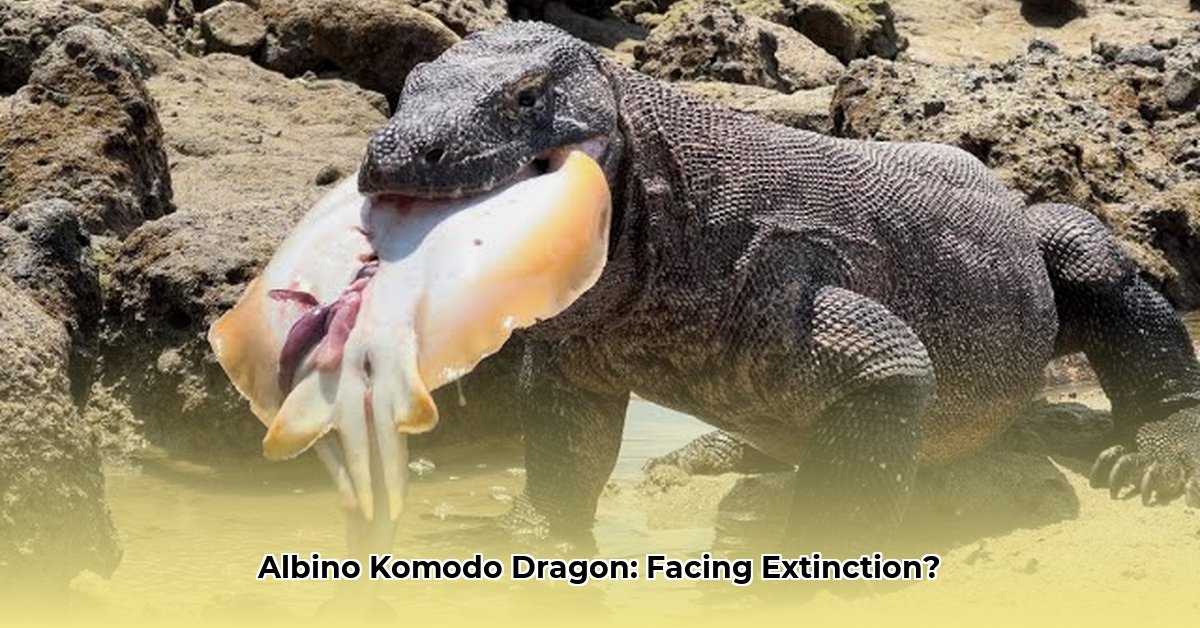
Albino Komodo Dragon: A Race Against Time
The albino Komodo dragon, a striking creature with nearly translucent white scales, faces an existential threat. Their stark coloration, unlike the cryptic camouflage of their pigmented counterparts, renders them highly vulnerable to predation and reduces their hunting success. This inherent disadvantage, coupled with their already low population numbers, paints a grim picture for their long-term survival. Precise population numbers remain elusive, highlighting a critical gap in our understanding and hindering effective conservation strategies. How can we effectively protect a species whose numbers we don’t even fully understand?
The Challenges These Unique Dragons Face
Several intertwined factors jeopardize the survival of albino Komodo dragons. Their conspicuous appearance makes them easy targets for predators, significantly impacting their survival rate. This vulnerability is exacerbated by their low population size, increasing the likelihood of inbreeding. Inbreeding reduces genetic diversity, weakening the population's resilience to disease and environmental changes. It’s analogous to a small family being more susceptible to inherited health problems than a larger, more genetically diverse one. The extent of inbreeding's impact on albino Komodo dragons remains largely unquantified, underscoring an urgent need for further research. What are the specific genetic consequences of inbreeding in this already vulnerable population?
Urgent Conservation Actions: A Plan of Attack
Saving these magnificent creatures requires immediate and concerted action across multiple fronts. A comprehensive strategy must include:
Strengthening Anti-Poaching Efforts: Increased patrols, community engagement, and technological advancements (such as SMART patrol systems using GPS tracking and data analysis) are crucial to deter poaching and illegal wildlife trade. Effective enforcement of existing regulations, coupled with community-based conservation initiatives, increases the chances of substantially reducing poaching rates.
Protecting and Expanding Habitats: Expanding and enhancing existing protected areas is paramount. This involves not just designating areas as protected, but actively managing these habitats to ensure the healthy ecosystem necessary for Komodo dragon survival. Habitat restoration and the creation of wildlife corridors can enhance connectivity between fragmented populations, aiding in their recovery.
Comprehensive Genetic Research and Population Monitoring: Large-scale genetic studies are critical to assess the extent of inbreeding, identify genetic bottlenecks, and inform breeding programs. Continuous population monitoring using advanced technologies (e.g., camera traps, DNA analysis from scat) will provide crucial data on population trends and inform adaptive management strategies.
Community Education and Sustainable Tourism: Educating local communities about the ecological and economic importance of Komodo dragon conservation is essential, fostering a sense of ownership and stewardship. Sustainable tourism initiatives can generate economic benefits for local communities, generating an incentive to protect these animals.
How to Improve Albino Komodo Dragon Conservation Efforts
Key Takeaways:
- Albino Komodo dragons face unique challenges, amplified by their conspicuous coloration and reduced hunting success.
- Effective conservation requires a multifaceted approach balancing technological advancements, community engagement, and strong policy frameworks.
- Sustained funding and rigorous monitoring are crucial to assess the effectiveness of conservation efforts and adapt strategies as needed.
- International collaboration is essential to share knowledge, resources, and best practices for the long-term success of conservation initiatives.
Addressing the Peculiar Challenges
Dr. Anya Sharma, Herpetologist at the University of Indonesia, emphasizes, "The albino Komodo dragon's distinctive coloration presents a unique set of challenges. Its reduced camouflage makes it more vulnerable to predation and less successful in hunting. This necessitates a targeted approach that goes beyond general Komodo dragon conservation efforts."
Technological Advancements
"SMART patrol systems, employing GPS tracking and sophisticated data analysis, are vital for combating poaching," states Mr. Budi Santoso, Head of Conservation at Komodo National Park. "Expanding their deployment however, requires substantial investment in training, maintenance, and technological upgrades."
Community Engagement: Building Partnerships
"Empowering local communities through sustainable tourism and education initiatives is key to long-term success," notes Ms. Ratna Dewi, Community Development Officer at a local NGO. "By fostering a sense of shared responsibility, we can ensure the protection of these magnificent creatures."
Policy and Enforcement: A Strong Foundation
"Robust policy, encompassing stricter poaching laws and effective habitat protection measures, forms the cornerstone of any successful conservation strategy," stresses Dr. Johan Widodo, Senior Policy Advisor at the Indonesian Ministry of Environment and Forestry. "This requires strong inter-agency collaboration and dedicated resources."
Funding and Monitoring: A Continuous Commitment
"Sustained funding and consistent population monitoring are the cornerstones of long-term success," adds Dr. Sharma. "Without these essential elements, even the best-laid plans will fail to deliver lasting results.”
Climate Change Adaptation: A Looming Threat
The impact of climate change on Komodo dragon populations cannot be overstated. Rising sea levels pose a direct threat to coastal habitats, potentially leading to displacement and habitat loss. A proactive approach, encompassing climate change adaptation strategies and habitat restoration efforts, is crucial to mitigate these risks.
International Collaboration: A Shared Responsibility
The conservation of albino Komodo dragons requires a global commitment. International collaboration, in the form of research partnerships, financial support, and the sharing of best practices, is vital to ensure a better future for this iconic species.